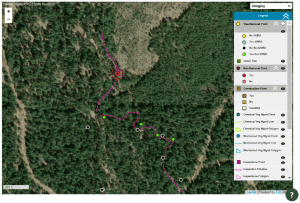Woodland Solutions Group, a DJ&A company, developed and implemented a vegetation management system for a prominent utility client. This system is built from the ground up by configuring Esri’s ArcGIS technology, which includes a streamlined map-based data collection platform (MobileMap) and a robust web-based Spatial data management system (Spatial CMS). Spatial CMS is a powerful GIS-based web application that is highly configurable and supports a broad range of field data collection, analysis, and management.While the utility industry often focuses on its efforts to manage vegetation near high-voltage transmission lines, there is a much larger quantity of utility infrastructure, including lower-voltage distribution lines, substations, hydroelectric dams, recreation areas, canals, pen stocks, etc. A vegetation management system was needed to protect this critical utility infrastructure from hazardous trees and encroaching vegetation, wildfire, and mitigating ignition risk around the utility infrastructure.
Key Services Provided
- Identified vegetation management tasks and established priorities.
- Developed robust field protocols and corresponding data models to support data collection and analysis.
- Configured our Spatial CMS solution to the client’s data gathering, compilation, and overall management needs.
- Supported purchase and configuration of field devices.
- Led on-site training for 50 staff and contractors.
- Provided support and training since 2018 including webinars, tutorials, and a dedicated helpdesk.
- Provided data quality control, analysis and reporting.
Value Added
- DJ&A’s substation scans provide clients with an existing conditions point cloud that can be integrated into a GIS system.
- This allows the client to analyze the current structural make-up of the substation and help with any scheduling of routine maintenance or compliance work that may be required due to updated regulations.
- This analysis can take place in a virtual team meeting with team members spread out across offices and regions with no site visit to each substation required every time routine maintenance is needed, or an expansion project is planned.









